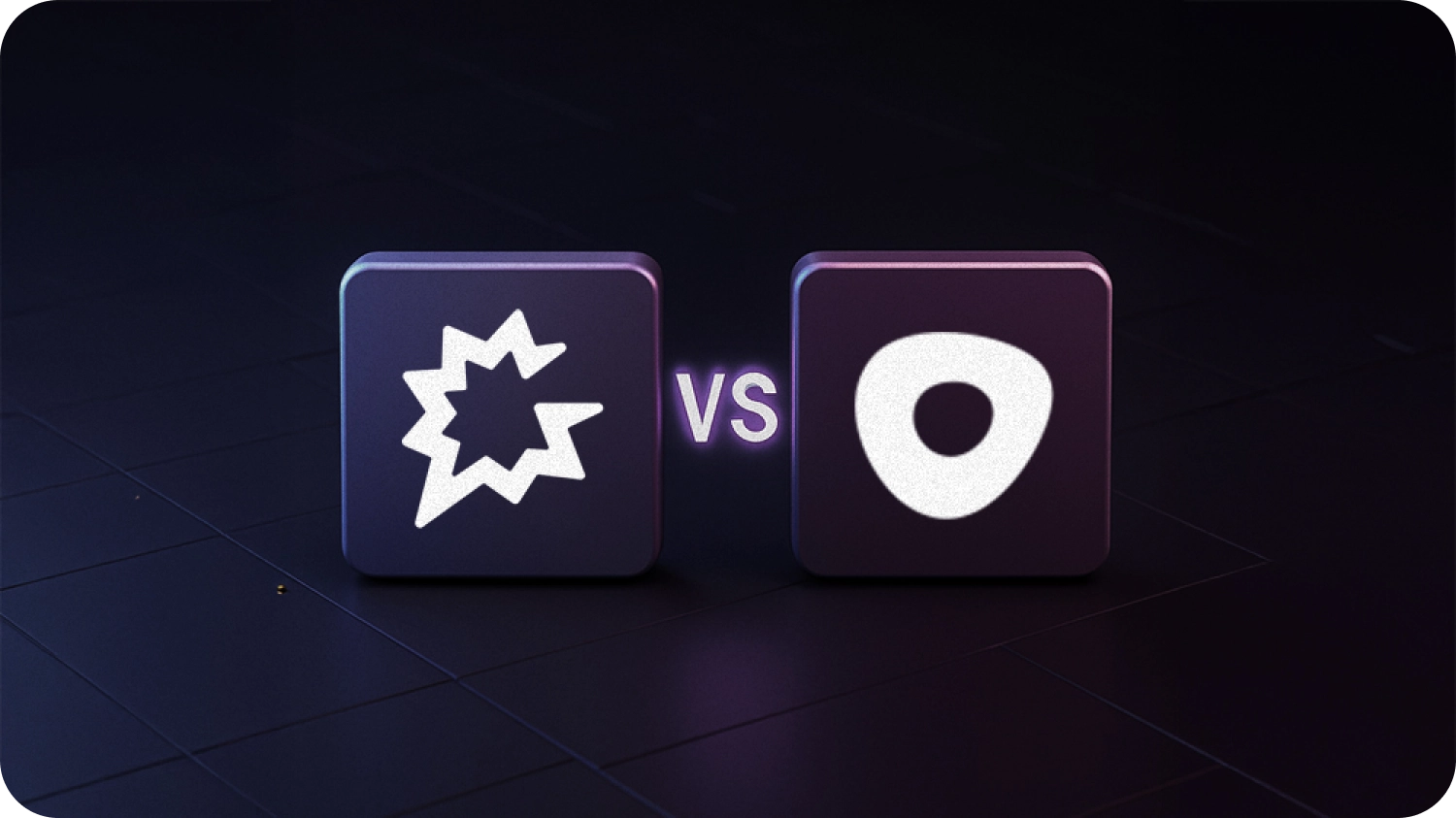If you're comparing Gong and Outreach, you're probably wondering the same thing most sales leaders are asking:
Why am I paying top dollar for two tools that seem to do the same thing?
You’re not alone. These platforms promise to improve rep performance, drive pipeline, and help you close more.
But once you dig into the details, it’s easy to feel like you’re overpaying for overlapping features.
In this blog, we will compare both the tools side-by-side to understand in detail what each delivers, where they overlap, and where one might be a better bet for your team.
What Is Gong?
Gong started as the conversation intelligence tool that sales leaders didn’t know they needed.
Its pitch was simple but powerful: record your calls, analyze what top performers do, and coach the rest of your team to replicate that success. And it worked.
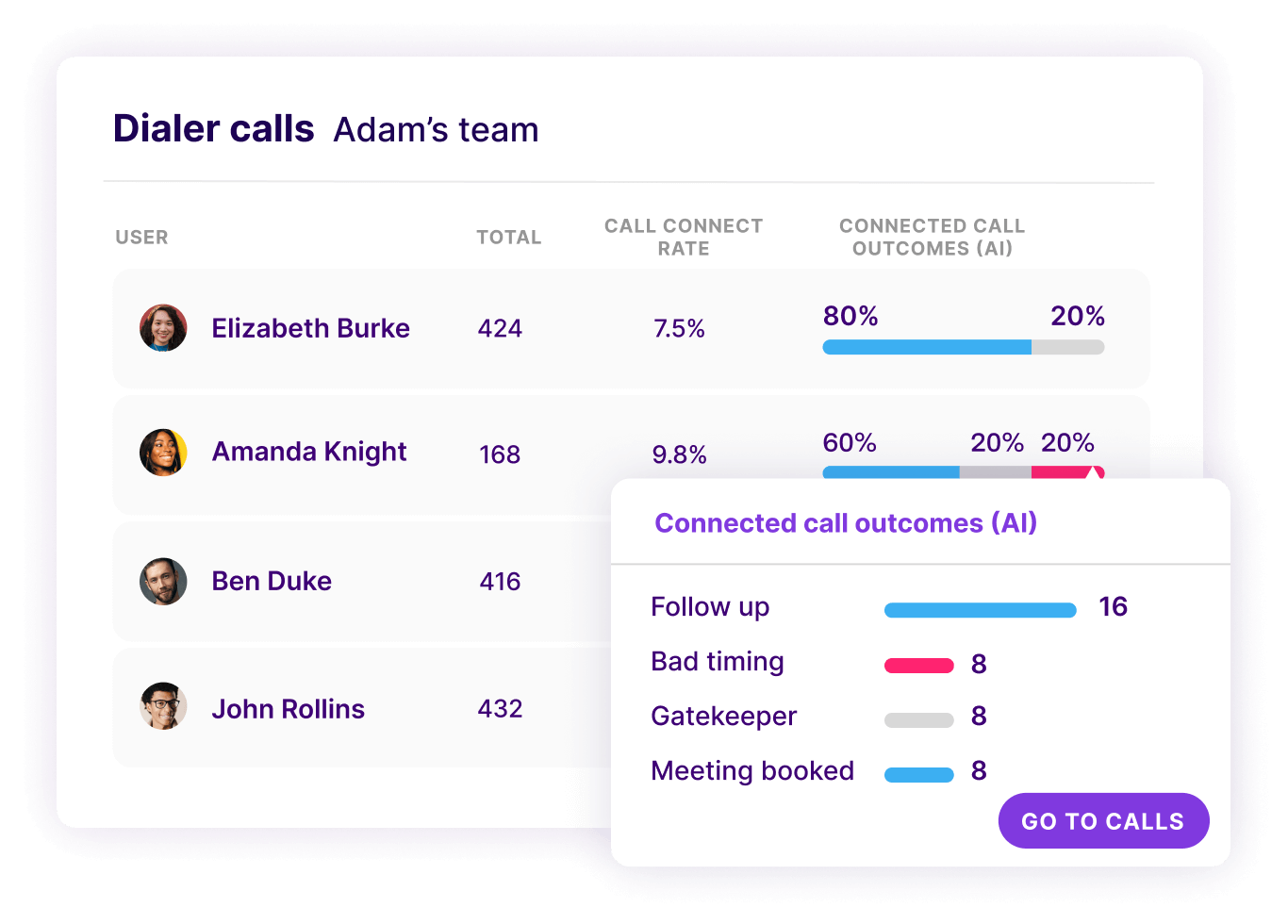
The platform filled a gap in a market full of CRMs that stored data but didn’t show what was really happening in deals.
Over time, Gong expanded beyond call analytics. It now sells itself as a “revenue intelligence” platform, pulling in data from emails, calendars, CRMs, and calls to forecast pipeline health, surface deal risks, and track rep activity. It wants to be your single pane of truth for go-to-market strategy.
In practice, Gong is known for sales coaching, deal visibility, and forecasting. Its dashboards are polished, and the AI insights are packaged well enough that CROs can share them directly with the board.
But Gong doesn’t run outreach sequences. It doesn’t handle task workflows or prospecting automation.
That’s where Outreach comes in.
The two products can work together, but there’s an overlap in rep-level activity tracking, deal inspection, and reporting.
If you’re paying for both, you should be clear about who owns what and whether that division is worth the investment.
What Is Outreach?
Outreach.io has always been about sales execution.
While Gong built its brand around post-call intelligence, Outreach focused on simplifying the daily grind for outbound teams. It gave reps a reliable place to create a pipeline: sequences, tasks, inbox management, calendaring.
And for a long time, that’s what defined it: a sales engagement platform that made prospecting repeatable and trackable.
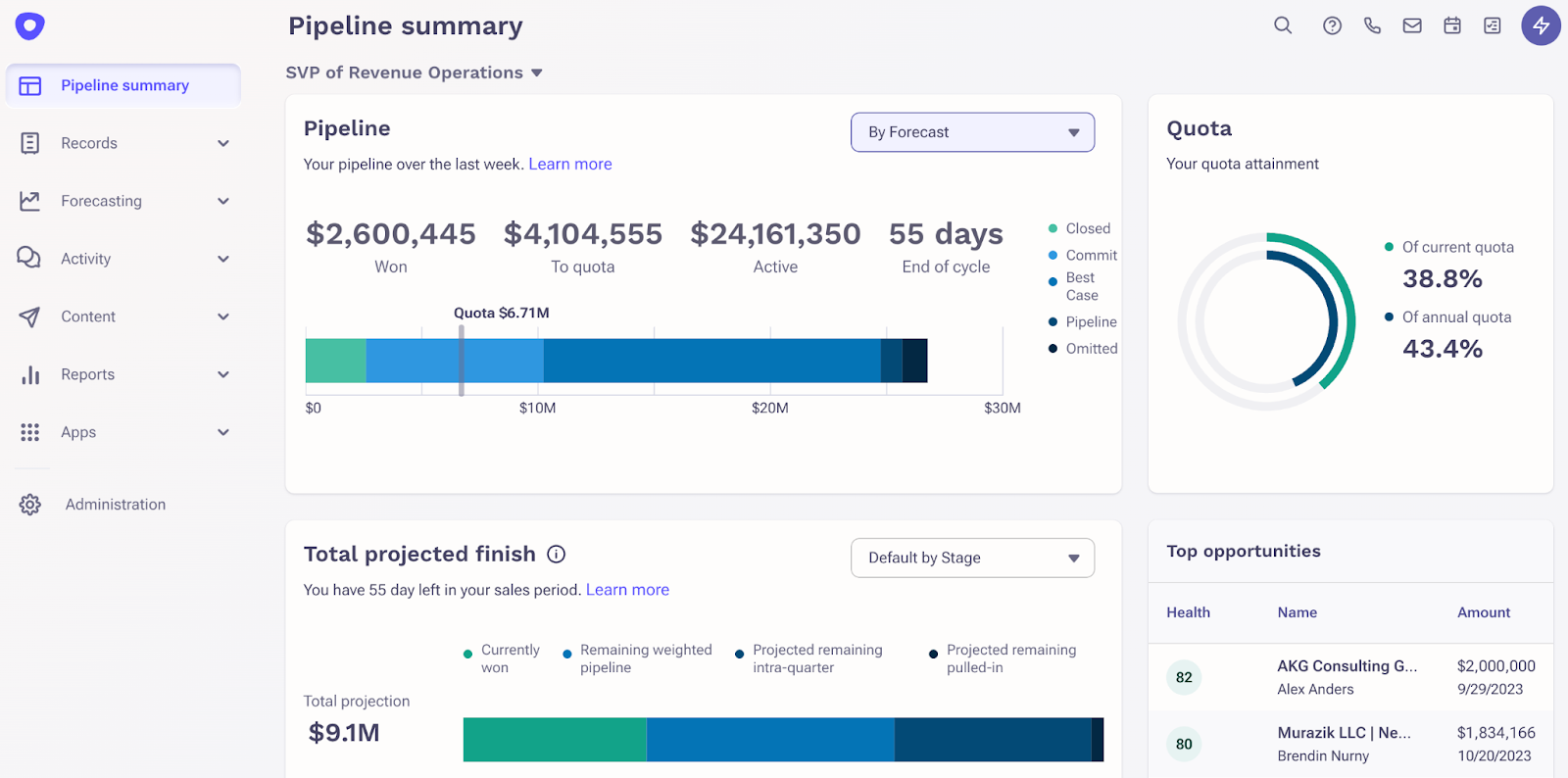
But Outreach has evolved a lot in recent years. The company’s recent positioning is less about reps and more about revenue execution.
It wants to serve both the AE and the CRO, offering forecasting, pipeline inspection, and deal management features that overlap with what Gong now does.
If Gong started from the conversation and worked its way toward revenue, Outreach started with workflows and is now angling for pipeline visibility.
The platform’s strength still lies in revenue orchestration. Outreach owns the daily rep workflow and handles sequencing across email, phone, and LinkedIn.
That said, it’s not a conversation intelligence platform in the traditional sense. And while Outreach has added more analytics, its roots are still firmly in action over analysis.
That’s where the real distinction from Gong begins to show.
Gong vs Outreach: Key Differences
This is where things start to blur, and where most buyers get stuck.
Since both tools operate in the sales execution space and share some overlapping features, Gong sometimes resembles a sales engagement tool, while Outreach looks like a revenue intelligence platform.
If you’re evaluating Gong and Outreach today, chances are you’re not just looking at Gong for post-call analytics.
You’re probably looking at Gong Engage, which is Gong’s bet in the outbound workflow. And that’s where the direct comparison with Outreach starts to get real.
Gong Engage was launched as a counter to Outreach’s dominance in rep productivity. It promises to help reps prioritize deals, manage follow-ups, and run multi-channel sequences.
That said, Gong Engage isn’t as good as Outreach. At least not yet.
Outreach has been refining its outbound infrastructure for nearly a decade. The platform handles sequencing with more flexibility, offers smoother automation, and supports better sales development workflows. Reps who live in Outreach don’t just prospect; they work their whole day out of it.
Gong Engage feels more like a strategic add-on than a workflow engine. It’s good for teams who are already in the Gong ecosystem and want some basic outbound execution features without onboarding a second tool.
But if you’re scaling outbound across multiple roles, need deep A/B testing, or want tight control over deliverability, Outreach wins hands down.
Where they differ most:
- Maturity of Sequencing: Outreach supports advanced branching logic, team-based sequences, and deep personalization options. Engage offers simpler flows geared more toward deal acceleration than prospecting at scale.
- Daily Rep Workflow: Outreach serves as the primary hub for SDRs and AEs. Engage still assumes reps will toggle between tools, which can limit adoption.
- Reporting and Forecasting: Gong wins here. Engage natively integrates with Gong’s broader intelligence layer to let sales managers see how rep activity connects to deal outcomes. Outreach’s reporting is good, but it’s still more operational than strategic.
If you’re choosing between the two, it comes down to this:
Do you need a high-powered outbound engine that reps can live in all day?
Or do you need visibility into how rep behavior ties back to revenue, with some add-on outbound capabilities?
Pricing Comparison: Gong vs Outreach
If you’re looking for a quick, apples-to-apples pricing page from Gong or Outreach, you won’t find one.
Gong doesn’t publish pricing publicly. Neither does Outreach. In any case, the final number you’ll pay depends heavily on your team size, modules selected, and contract term.
Let’s start with Gong.
Based on our research and first-hand user accounts available in online sales communities, here’s how Gong’s pricing generally stacks up:
- Starting cost: Around $5,000 per year for basic call recording and transcription access.
- Pro plan: Roughly $1,600–$2,000 per user per year when you layer in conversation intelligence, deal boards, and analytics.
- Enterprise rollouts: Can exceed $100K+ annually for mid-sized to large teams when forecasting, CRM integrations, and Gong Engage are added.
- Contract terms: Typically annual, with multi-year discounts. No real self-serve or usage-based tiering.
- Gong Lite: Recently, Gong has also introduced a lighter plan for smaller teams starting at $1,000/month. However, it caps usage at 10 users and limits access to advanced features like deal insights, forecasting, and AI coaching. It’s more of a lead-in tier than a true SMB option.
The takeaway: Gong is not a plug-and-play tool. You can’t really ease into it. The company prices like it expects full-scale deployment across your sales org, and that shows up in the quote.
Next, let’s talk about Outreach. While more flexible in its offering, Outreach still commands a premium, especially when you start scaling across teams and adding functionality. Per Woodpecker’s pricing analysis and verified user reviews:
- Basic plan: Starts around $100 per user/month, billed annually.
- Implementation costs: One-time fee starting at $1,000.
- Onboarding fee: Some customers say Outreach quoted them up to $8,000 for onboarding, based on their team size and setup needs.
In real numbers: A 20-person sales team on Outreach’s basic plan at $100 per user/month would pay around $24,000 per year, plus a one-time implementation fee starting at $1,000.
If you include add-ons or advanced packages, the cost can go up to $38,000–$45,000 a year. With onboarding, the first-year total cost can easily go past $50,000.
With Gong, the same team could be looking at $80,000+ per year, especially if you’re activating Gong Engage and the full forecasting suite.
Both tools are built for serious sales orgs. But if you’re price-sensitive or trying to justify value on a per-seat basis, the math gets important very quickly.
And so does clarity about which platform owns which part of your sales stack.
User Reviews and Common Complaints
If you go deep enough into review sites and Reddit threads, you’ll start to notice a pattern. Both Gong and Outreach have loyal users. Both have vocal critics. And both get pulled into sales stacks for similar reasons: visibility, efficiency, and rep productivity. But once teams go live, the day-to-day experience starts to diverge.
Let’s start with Gong. Most users praise Gong’s core strengths around post-call insights, searchable recordings, and coaching workflows. The interface gets high marks for usability. The call transcription is generally considered accurate, and the deal boards help leadership keep a pulse on pipeline health without chasing reps for updates.
“I like how quick, intuitive and actually useful it is. I use gong for several purposes: education (I could watch my colleagues work when was a new-joiner), call recording + notetatking + summaries & todos, and client contact automation using flows. Last part if what I like the most - there's a really nice flow editor which allows to define multiple steps (omnichannel e.g. mail + linkedin), select if it's an auto-step or a manual one with a reminder, use templates, blocks with dynamic elements and more. Then there's stats and insights which help understand how you do. Gong "Anywhere" add-on for Chrome is great - I often use it when I work in Salesforce.”
Robert G., Enterprise AE, from G2 reviews
“I like how well organized the UI is, how easy it is to implement, and the many features that allow me to search through conversations to get the data and insights I need.”
Michelle O., Senior Customer Success Manager, from G2 reviews
Where things get sticky is with Gong Engage. Multiple users, especially on Reddit, have shared that while the Engage module looks promising on paper, it lacks the flexibility and depth of more mature sales engagement tools.
“No integrations and very bad deliverability. I am currently using Apollo for leads and smartreach for emails going good so far , also a/b testing does not work very well because they do not tell you which participant received which variable which is messy.”
Internal_Cut_1042, from reddit
“We migrated from Outreach to Gong Engage a couple of months ago and our sales team absolutely hates it. It feels as if it is still in beta development, I’d wait for it to be around a bit more.”
farineta46, from reddit
From a support perspective, Gong generally receives solid feedback. But as the platform has scaled and added more enterprise-grade modules, some smaller teams mention that post-sale support feels slower or more ticket-based than hands-on.
Outreach, on the other hand, gets consistent credit for being rep-centric. Many SDRs and AEs live in Outreach all day. The sequencing engine is still considered one of the most robust on the market.
“Outreach is an incredibly effective tool that has significantly boosted my team’s productivity in sales outreach. The ability to schedule emails in advance and place prospects into automated sequences streamlines long-term engagement without constant oversight. It also helps me stay organized by tracking follow-up tasks like calls. One of the most valuable features is its email tracking, which shows opens and clicks, making it easier to identify engaged prospects. While Outreach also offers additional analytics, we haven’t fully explored those yet, but they show promise for deeper insights.”
Jainil P., BDR, from G2 reviews
It handles multi-channel workflows, task prioritization, and automated follow-ups with a degree of control that’s hard to match. Teams that run high-volume outbound motions rely heavily on Outreach to keep their motion running.
“Outreach is now at the center of our sales momentum. I love most how it brings together email tracking and conversation intelligence to allow our team to connect with the right message at the right moment. It's so powerful at scaling personalized outreach without compromising that human touch.”
Jennifer H., Director of Sales, from G2 reviews
But it’s not without flaws. Common complaints center around performance lags, especially for larger teams with more complex sequences or integrations.
“The Engage product is stagnant. Looks to have the same features, UX, integrations and issues as it had 5 years ago. Frequent requests for a product roadmap or understanding how AI is involved is glossed over by the CS team and the AEs talk grandly about all the featured of the tool - and how industry leading it is - but shy away from demonstrating this. This is confounding.”
Matthew T., Head of RevOps, from G2 reviews
Outreach’s reporting gets regular criticism for being basic; good for activity tracking, but not much beyond that. The interface can feel clunky, and because it relies on your own email servers, deliverability and tracking can be limited.
There’s also frustration around contracts. Outreach tends to auto-renew agreements annually, with strict cancellation windows.
“Outreach is significantly overpriced for what it offers. The platform has a clunky interface and still relies on your own email servers, essentially functioning as an email scheduler with very basic reporting capabilities. Additionally, their agreements are evergreen- automatically renewing annually without alternative terms. If you miss the cancellation deadline by even a few hours (be mindful of their time zone), they enforce renewal for the entire year without any willingness to negotiate. This lack of flexibility makes for a frustrating and rigid customer experience.”
A few recurring issues include:
1. Gong
- Pros: Strong call insights, powerful coaching tools, deal visibility, clean UI
- Cons: Gong Engage feels undercooked for outbound teams, CRM sync quirks, higher ramp-up for smaller orgs
2. Outreach
- Pros: Best-in-class for outbound sequencing, solid daily workflow tool for reps, customizable task automation
- Cons: Occasional performance slowdowns, reporting feels limited for strategic planning, can get complex to administer
MeetRecord: An All-in-One Alternative for Revenue Teams
If you’ve been in B2B sales long enough, you’ve probably felt this pain: you buy a tool to record calls, another to run outbound, and a third to manage the pipeline.
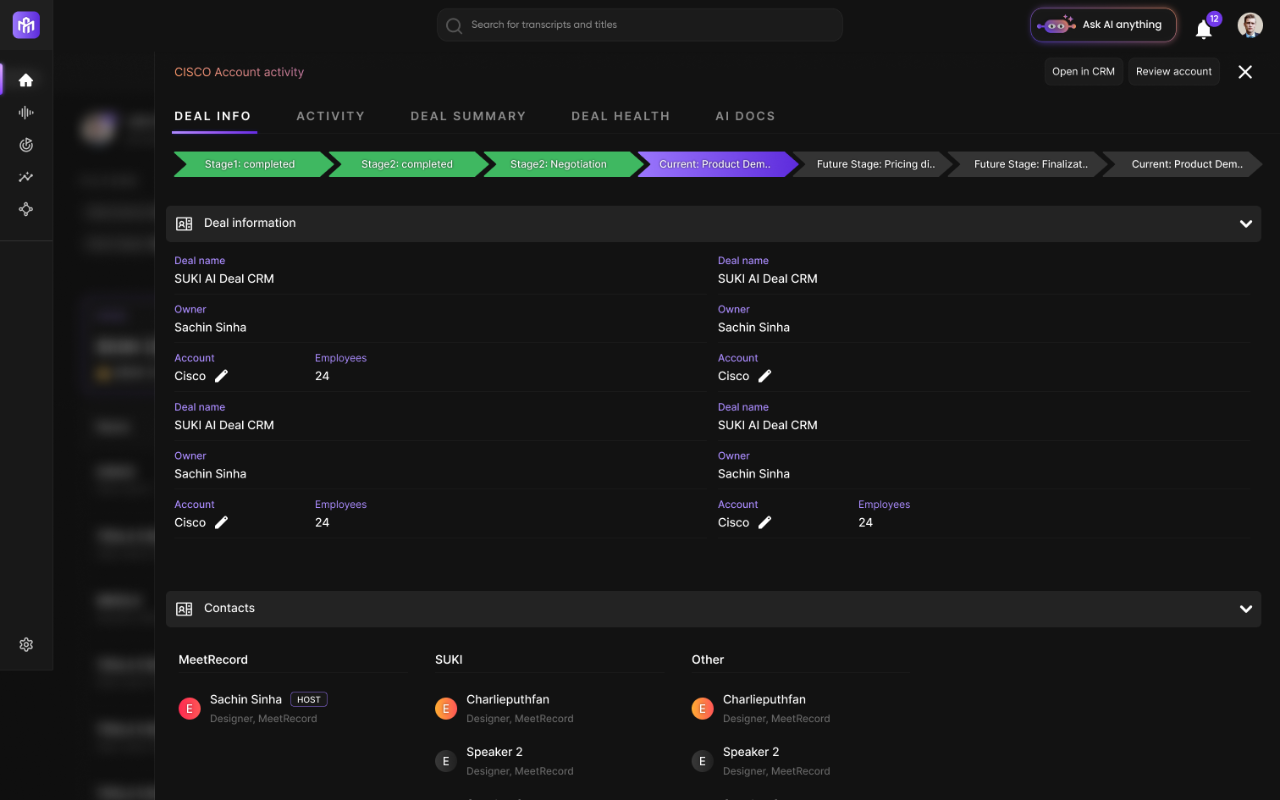
Before you know it, your stack looks like a Jenga tower of overlapping subscriptions.
Gong and Outreach are powerful. But when bundled together, they can feel like too much platform for too little adoption. And too much money for what you actually use.
That’s where MeetRecord is quietly carving out a different path.
At first glance, it might seem like just another conversation intelligence tool. But if you look closely at how MeetRecord compares to Gong, you’ll notice something more deliberate.
The product is built with early and mid-stage teams in mind. Teams that care about visibility and coaching, but also want real outcomes like faster ramp time, tighter pipeline hygiene, and better conversion rates across the board.
MeetRecord combines call recording, deal insights, and AI-powered role-play…all in one interface. You don’t need separate tools for conversation intelligence, coaching, pipeline management, or rep enablement.
The platform doesn’t just show you what’s wrong in the funnel. It gives your reps a space to practice and improve with AI-driven feedback. That’s a key gap most revenue tools miss.
Where Gong and Outreach often feel enterprise-first, built to be sold top-down, MeetRecord is built to be used bottom-up. Sales managers can run coaching sessions, track talk ratios, and drill into objections.
Reps can run mock calls and get instant feedback without waiting for a manager review. Leadership gets reporting that maps activity to pipeline health without needing to ask RevOps for a custom dashboard.
And then there’s pricing.
While Gong starts high and Outreach adds up quickly, MeetRecord keeps things lean and predictable.
It doesn’t charge a platform fee, and per-user pricing ranges from $660 to $1,200 per year, depending on team size. That’s significantly lower than Gong’s $1,300–$1,600 per user plus a hefty $5,000 platform fee.
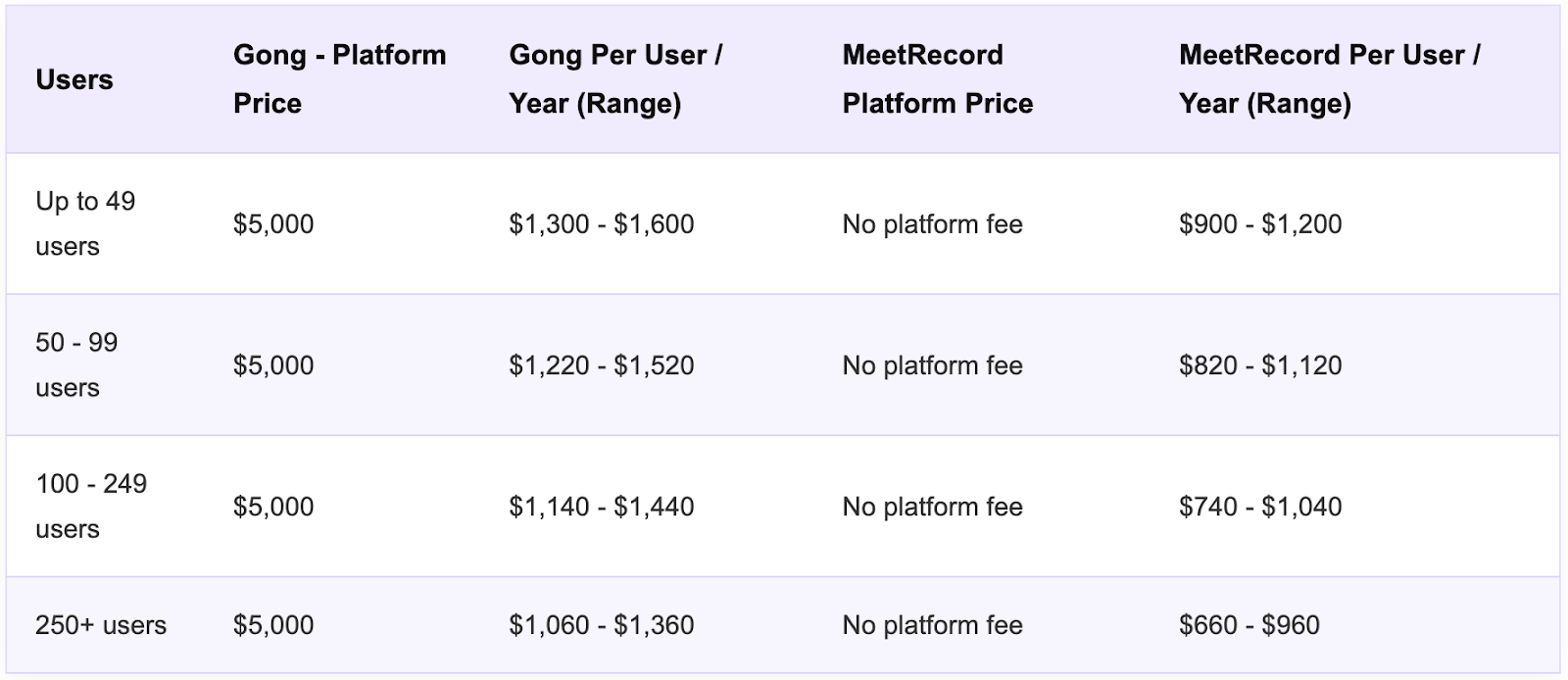
MeetRecord is built for teams that want enterprise-grade capability without enterprise-grade bloat.
Outreach vs Gong: Which Tool Should You Choose?
Choosing between Gong and Outreach isn’t just a feature-by-feature decision. It’s a bet on how your team works and how you expect it to evolve.
Gong gives you deep post-call insights, coaching workflows, and pipeline visibility. Outreach gives you structure, speed, and execution for outbound teams.
If you’re a large sales org with specialized roles, defined workflows, and budget flexibility, using both may still make sense.
But for most companies, that level of investment is hard to justify and even harder to operationalize.
Our honest take: most revenue teams don’t need two separate platforms doing half the job each.
MeetRecord is a much better bet than using both. It combines AI-driven call insights, live coaching, deal tracking, and outbound engagement…all in one place.
You don’t have to choose between intelligence and execution. With MeetRecord, you get both in one product and at a fraction of the cost.
If you're rethinking your stack or trying to avoid bloated tooling in the first place, MeetRecord is worth a look. Book a demo to see how your sales team can do more, without adding more tools.
Frequently Asked Questions
Outreach is a sales execution platform focused on sequencing, task automation, and outbound workflows. Gong, on the other hand, is a conversation intelligence and revenue insight platform designed to analyze sales calls and surface coaching opportunities. MeetRecord combines key capabilities of both with AI-powered call analysis and sales coaching, with lighter setup and lower cost.
Outreach and Salesloft offer similar features, but Outreach is generally preferred for its more mature sequencing engine, deeper task automation, and rep-centric workflows. Salesloft appeals to teams seeking simplicity and tighter Salesforce integration.
Outreach pricing typically starts around $100 per user/month, billed annually. Implementation and onboarding can add thousands more upfront. Full-featured deployments often exceed $45K–$50K/year for mid-sized teams.
Gong starts around $5,000/year for basic access. Full-featured plans with Engage, forecasting, and integrations often cost $1,600–$2,000 per user/year. Platform fees and contract lock-ins can push total annual spend over $80K+ for midsize teams. In contrast, MeetRecord offers similar coaching and intelligence capabilities at $660–$1,200 per user/year with no platform fee.
Yes. MeetRecord is built as a leaner alternative, combining call recording, coaching, deal insights, and outbound follow-ups in one platform. It’s ideal for growing teams that want intelligence and execution without bloated pricing or tool sprawl.

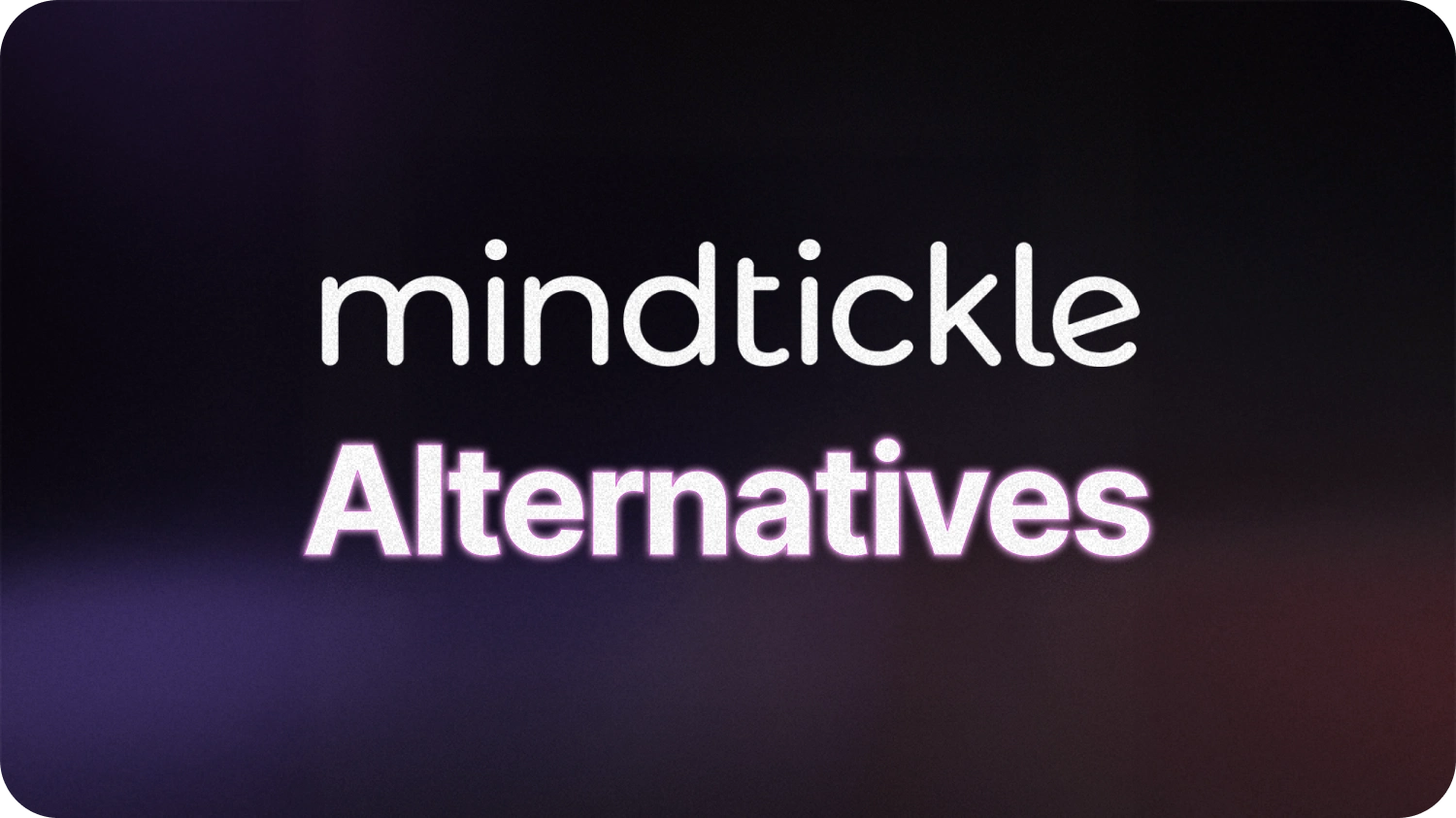
.svg)

.png)

